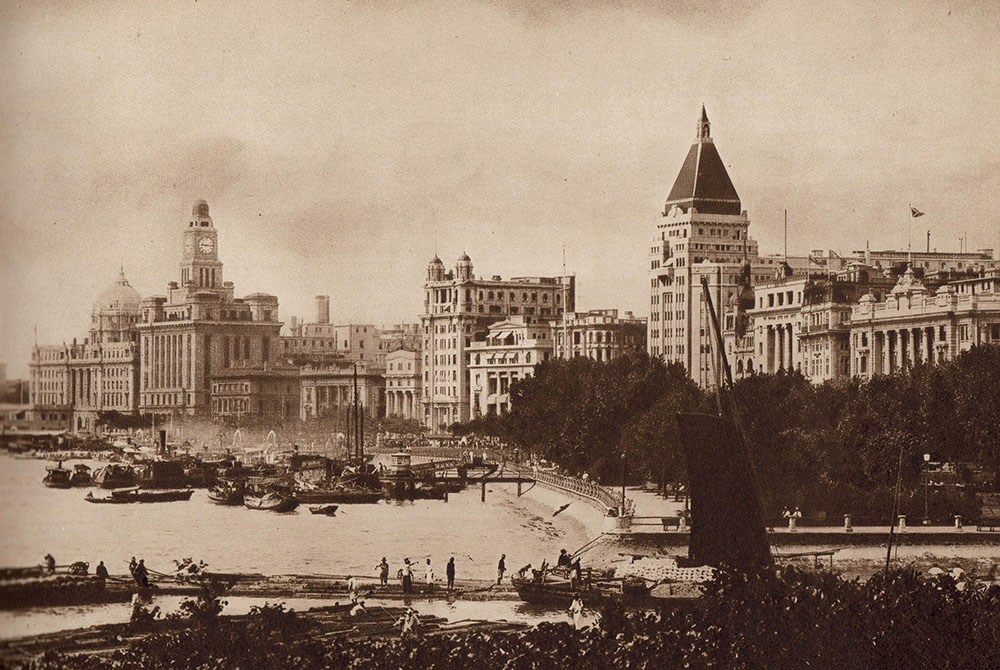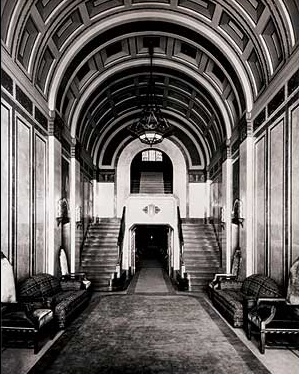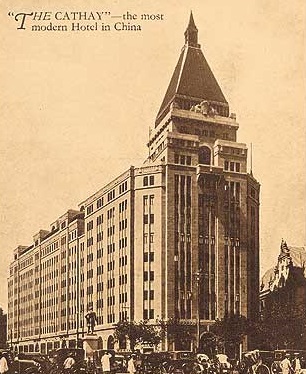Receive for Free - Discover & Explore eNewsletter monthly with advance notice of special offers, packages, and insider savings from 10% - 30% off Best Available Rates at selected hotels.
history
Discover the Fairmont Peace Hotel, which has been a cherished local landmark on Shanghai’s historic Bund for more than a century.
Fairmont Peace Hotel, a member of Historic Hotels Worldwide since 2018, dates back to 1929.
VIEW TIMELINEHistory of the Fairmont Peace Hotel
Discover the decades of history that have unfolded inside the Fairmont Peace Hotel. This fantastic holiday destination has been among Shanghai’s most exclusive retreats for more than a century, hosting the likes of Sun Yat-sen, Charlie Chaplin, and George Bernard Shaw.
WATCH NOWA member of Historic Hotels Worldwide since 2017, the Fairmont Peace Hotel’s amazing story involves two buildings that have stared at one another for decades. On each side of the Nanjing Road are the North Building and the South Building. Historically, both structures have been a part of the Peace Hotel. Today, though, only the North Building is still affiliated with the business. Originally called the Sassoon House, Sir Walter Sassoon began constructing the North Building in 1926. Sassoon and his team of contractors selected Gothic Revival-style architecture for its design. The construction project was massive! The North Building soon took up 120,000 square feet of floor space spread across 10 stories. When construction concluded some four years later, it stood as one of the first high-rise structures ever raised in the Eastern Hemisphere.
Shortly after the North Building opened in 1929, five of its floors debuted as The Cathy Hotel. The establishment quickly gained a distinguished reputation, as its copper-sheathed roof, Italian marble floors, and Lalique glass artwork won over many patrons. In particular, the hotel’s Old Jazz Bar became an immensely popular attraction. Its 6 veteran musicians regularly performed before packed crowds! The business’s prestige grew to such an extent that celebrities and politicians from across the globe began visiting frequently. International luminaries like Charlie Chaplin, George Bernard Shaw, and General George C. Marshall all lodged at The Cathy Hotel. But the North Building did not remain a hotel forever. After the founding of the People’s Republic of China, the local branch of the Chinese Communist Party began moving its Municipal Finance Committee into the structure. By 1952, the entire building functioned as a municipal government office. Yet, the city government had a change of heart a couple of years later. It opted to transform the North Building back into a hotel, reopening it as the “Peace Hotel.”
Across the street, the South Building predated its sibling by almost a century. First constructed in 1854, the South Building functioned as the “Central Hotel” for many years until the early 1900s. At that point, the South Building’s ownership decided to significantly renovate the structure, rebranding it as the Palace Hotel. It went on to host numerous international luminaries, the most notable of which was the Chinese revolutionary Sun Yat-sen. The South Building’s stint as the Palace ended abruptly during World War II, however, when the Japanese military occupied the hotel. The Chinese government then seized the building a few years later upon the conclusion of the Chinese Civil War. Throughout much of the 1950s and the 1960s, the Chinese Communist Party ran the headquarters of Shanghai’s Municipal Construction Department out of the South Building. But as with the adjacent North Building, local politicians eventually decided to convert the South Building back into a hotel. In 1965, the South Building relaunched as a wing of the North Building’s Peace Hotel.
The two historic buildings operated together as the Peace Hotel for nearly fifty years! Nevertheless, change was coming once more to the hotel. In 2007, both the North and South Buildings closed for an extensive period of renovation in preparation for the 2010 World Expo. As a result, both the North and South Buildings were separated into their own unique businesses. Developers transformed the older South Building into The Swatch Art Peace Hotel, which has since specialized in offering luxurious apartment accommodations for traveling artists. Meanwhile, Fairmont Hotels and Resorts acquired the North Building, which retained its identity as the Peace Hotel. But while only the North Building constitutes the historic Fairmont Peace Hotel today, each structure continues to serve as a terrific reminder for their remarkable shared past.
-
About the Location +
Located along the western bank of the Huangpu River, the Bund is one of Shanghai’s most iconic neighborhoods. This fantastic district has entertained thousands of visitors every year since the dawn of the 21st century, as The Bund is home to countless upscale storefronts, galleries, and restaurants. Yet, The Bund’s history extends much farther back from its recent emergence as an international tourist destination. The Bund first rose in prominence as the central entry point for the arrival of foreign commerce into Shanghai during the 19th century. Starting with the British in the 1840s, a few dozen Western nations began establishing many wharves and warehouses in the area. Prior to this moment, The Bund had been little more than a wetland inhabited by a few local farmers. Soon enough, the disparate foreign communities coalesced into one unified town known as the “International Settlement.” The local maritime trade proved to be incredibly lucrative, though, which led to the region’s rampant urbanization. As such, many beautiful office buildings began to emerge that displayed a wealth of unique architectural styles ranging from Beaux-Arts to Neoclassicism. Yet, many of the trade guilds that dominated the local economy gradually gave way to financial institutions that regulated the influx of Shanghai’s foreign trade. Among the most prominent of those entities were the Hong Kong Shanghai Banking Corporation (HSBC) and the exclusive, Chinese-operated Bank of China.
The special fusion of Western and Chinese culture continued unabated during the first few decades of the 20th century. The Bund’s landscape became more distinctive as all kinds of unique architecture surfaced in the neighborhood. Additional immigrants from Europe and the Middle East contributed greatly to this period of urban expansion, the most notable of which was Sir Victor Sassoon. He subsequently erected dozens of buildings that resembled American skyscrapers throughout the neighborhood, including The Cathay Hotel. It was around this time that many in Shanghai referred to the district as “Bund,” which meant “embankment” or “embanked quay.” Its name was largely in reference to its geographic location along the Huangpu River. Yet, the Bund also built a reputation for its thrilling cultural atmosphere, as countless social clubs and dance halls became the site of many exhilarating soirees. Jazz in particular became synonymous with the neighborhood. The Cathay Hotel was the epicenter for its proliferation across the Bund, as its Old Jazz Bar hosted live performances nearly every night. The Bund’s prosperity came to an end with the outbreak of the Second Sino-Japanese War, as the Imperial Japanese Army began occupying Shanghai in the late 1930s. Fortunately, Shanghai—including the Bund—has long since recovered from the war, reemerging as one of China’s most economically vibrant destinations. The Bund has been at the heart of this transformation, offering to modern travelers a wealth of amazing cultural attractions to experience today.
-
About the Architecture +
The Fairmont Peace Hotel is divided into two buildings appropriately named as the North and South buildings. Redesigned with Chicago Commercial-style architecture, the two structures are celebrated throughout Shanghai for their timeless architectural elegance. This unique architectural form first emerged in America’s Windy City at the height of the Gilded Age before spreading across the globe to places like China. While no actual “school” existed in Chicago that taught the aesthetic, historians today agree that a common set of design principles unified the city’s architects around the turn of the 20th century. Among the most well-known features of Chicago Commercial-style buildings involved the use of steel frames clad in masonry (usually terra cotta). The reliance upon steel and durable masonry came about following the aftermath of the Chicago Fire of 1871, when most of the city’s preexisting structures were destroyed in the calamity. But the building materials also allowed for architects to install many large plate-glass windows throughout the façade. Called the “Chicago window,” thee fixtures consisting of three-parts centered along a panel that was flanked by two smaller sash windows. The arrangement resembled a grid, in which some spaces projected out from the exterior and formed bay windows.
Yet, the architects within the Chicago Commercial-style school of thought also believed that their buildings should reflect the prosperity and technological progress of the Industrial Revolution. As such, the structures borrowed several powerful aspects of Neoclassical architecture. Chicago Commercial-style skyscrapers were typically divided into the three distinctive sections that have historically formed what is known as the “classical column.” The lowest parts of the building acted as the base, where the most ornate architectural elements appeared. Much of the detailing occurred around the entryways, as well as any nearby windows. The middle floors of the structure often featured far less detail, which functioned as the “shaft” of the column. The grand ornamentation returned toward the final two stories, though, creating what architects called the “capital.” The “capital” was typically defined by its flat roof and brilliant cornice, as well. Many buildings across Chicago brilliantly encapsulated this architectural approach, such as the Reliance Building, the Chicago Building, and the Rookery Building.
-
Famous Historic Guests +
Sun Yat-sen, leader of the Xinhai Revolution and First President of the Republic of China (1912)
Charlie Chaplin, renowned actor known for his silent roles in The Kid and A Woman of Paris.
George Bernard Shaw, world-famous playwright known for works such as Man and Superman, Pygmalion, and Saint Joan.
George C. Marshall, 15th Chief of Staff of the United States Army (1939 – 1945)
-
Film, TV and Media Connections +
Empire of the Sun (1987)
The Last Aristocrats (1989)
Center Stage (1992)
Shanghai Triad (1994)
The Music Box (2002)
Leaving Me, Loving You (2004)
White Countess (2005)
The Silent War (2012)
Tiny Times 3 (2013)





























